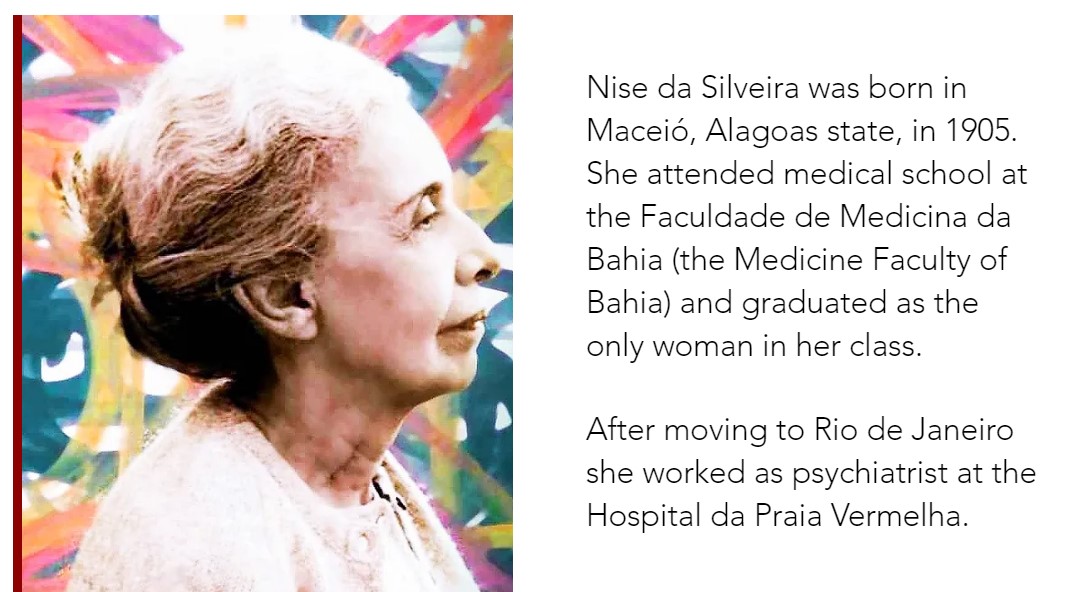A new essay explores the revolutionary work of Nise da Silveira, Brazilian psychiatrist and founder of the Museum of Images of the Unconscious in Rio de Janeiro, who radicalized Brazilian clinical practices during the 1940s and offers insight into alternative frameworks that challenge the prevailing dominant ideology of the field.
Published in Displacing Theory Through the Global South, the essay is written by Marlon Miguel of the ICI Berlin Institute for Cultural Inquiry. He writes to highlight underrepresented leaders of the Global South and outline how Nise’s work could significantly contribute to the history of radical and critical psychiatry.
Miguel investigates Silveira’s innovative practices involving artistic expression as a treatment for psychosis. He puts her work in conversation with Frantz Fanon and other European psychiatrists, highlighting where it extends and departs from established theoretical frameworks.
He writes:
“She unsettles established theoretical frameworks in psychiatry and psychoanalysis without rejecting them altogether: she reconfigures unorthodox concepts coming from polemical streams of psychoanalysis; she thinks very early about how to use unconventional elements in the clinical setting (such as animals, for example); she transforms artistic expression into the core of the treatment of mental disorder and discards more medicalized strategies.”
Miguel’s essay, “Inner World and Milieu: Art, Madness, and Brazilian Psychiatry in the Work of Nise da Silveira,” examines how Silveira’s use of art therapy as a clinical method disrupted traditional psychiatric frameworks. By placing her work alongside thinkers like Frantz Fanon, Miguel illustrates the unique and compassionate nature of Silveira’s approach, which prioritized the lived experiences of patients and rejected violent treatments like electroshock and lobotomy. Her emphasis on the therapeutic milieu and non-verbal expressive activities provided a humane and effective alternative to the dominant psychiatric practices of her time.
 With a growing interest in historical movements and figures that offer alternative and radical approaches to psychiatric practice, the contributions of the Global South continue to be underrepresented and overlooked despite the vast knowledge that came from the innovations of the Brazilian Psychiatric Reform.
With a growing interest in historical movements and figures that offer alternative and radical approaches to psychiatric practice, the contributions of the Global South continue to be underrepresented and overlooked despite the vast knowledge that came from the innovations of the Brazilian Psychiatric Reform.
Miguel highlights and investigates the work of Nise da Silveira, whose radical and compassionate ideas predated the reform. He writes to show “a dimension that was already there, operating in her practice, but that has not been investigated so far.”
Reconsidering the Space
Notably, Miguel highlights the significance of the notion of “milieu” and the rethinking of clinical space in her work, which he says has been very little researched.
Miguel provides a quote from Nise that demonstrates one of her main critiques that isolating a psychiatric patient from their usual milieu and placing them in a hospital will solidify the pathology:
“The hospital reinforces the pathology because it does not help to re-establish the connections between the patient and their milieu, from which they were separated because of the pathology. […] The hospital becomes an extremely efficient apparatus for the chronification of pathology.”
Her work emphasized a co-therapeutic element rather than the historical and prevailing patient-doctor relationship. Her treatments centered on activity and artistic expression as a way for individuals to work through psychosis and find their unity that has been disrupted.
Silveira and Fanon
Miguel finds similarities between Nise da Silveira’s and Frantz Fanon’s work. While they did not read each other’s work, he suggests the similarities result from their situatedness within the Global South context and their living in societies where the psychiatric institution plays a direct role in social control and alienation.
Both Fanon and Silveira emphasized the importance of considering the lived experience of the patient and addressing social exclusion caused by mental illness, and they critiqued the psychiatric institution and its role in social regulation. However, Silveira departed from Fanon in how she sought to address psychosis in a non-medicalized and non-violent way, avoiding electroshock treatments and lobotomies.
Miguel writes:
“She claims that it is necessary to move away from the excessive attention usually given to diagnoses and the symptoms of the pathology; rather, one should structure a supportive milieu that allows for the patient’s affective world to be re-articulated. In cases of severe psychosis, when speech is lacking or completely disarticulated, Nise further emphasizes the need for non-verbal expressive activities such as painting.”
Artistic Expression as a Clinical Means
In the psychiatric hospital, Nise encourages collective and creative activities. Miguel writes that her idea of creating a museum inside the hospital blurs the boundaries between the inside and outside and makes madness visible to the public.
Not only did her innovative approach create an archive with an abundance of artwork, but she also let individuals experiencing psychosis reveal their journeys through their states, sufferings, and traumas.
Miguel’s piece celebrates and uplifts the profound contributions of Nise da Silveira as a historic leader of psychiatric reform. He highlights the transformative power of art therapy and reminds us to direct our attention to the vast knowledge of alternative mental health research methods within Brazil and the Global South, as well as the urgent need to decolonize the discipline.
He concludes,
“Years before Anti-Psychiatry, which flourished in the 1960 and 1970s, a psychiatrist within an authoritarian Global South context was already practicing radical and critical alternative strategies of care.”
“Today, in the highly medicalized times we live in, marked by a renewed organicist vision of mental disorders, coming back to Nise’s reflections and practices — as well as to the Brazilian history of psychiatry and psychoanalysis — would definitely bring fresh and powerful perspectives to current clinical debates.”
****
Miguel, M. (2024). Inner World and Milieu: Art, Madness, and Brazilian Psychiatry in the Work of Nise da Silveira. In I. Dulley & Ö. Eylül İşcen (Eds.), Cultural Inquiry (Vol. 29, pp. 125–148). ICI Berlin Press. https://doi.org/10.37050/ci-29_09 (Link)















“The hospital reinforces the pathology because it does not help to re-establish the connections between the patient and their milieu, from which they were separated because of the pathology. […]” Or for any other unethical reason any doctor chooses … like profiteering off of covering up easily recognized malpractice, or medical evidence of child abuse, in the patient’s child’s medical records … a systemic problem for the DSM “bible” billers.
https://www.psychologytoday.com/us/blog/your-child-does-not-have-bipolar-disorder/201402/dsm-5-and-child-neglect-and-abuse-1
“The hospital becomes an extremely efficient apparatus for the chronification of pathology.” Indeed. Especially for the criminal doctors, like my former – now FBI convicted – hospital doctor.
https://www.justice.gov/usao-ndil/pr/oak-brook-doctor-sentenced-two-years-prison-connection-kickback-scheme-sacred-heart
“Miguel writes that [Nise da Silveira’s] idea of creating a museum inside the hospital blurs the boundaries between the inside and outside and makes madness visible to the public.” My artwork does that, too. But it is “too truthful” for the non-medically trained “mental health professionals,” who are seemingly largely in denial about the iatrogenic illness creation systems of today’s psychiatric “profession.”
https://www.amazon.com/Anatomy-Epidemic-Bullets-Psychiatric-Astonishing-ebook/dp/B0036S4EGE
https://en.wikipedia.org/wiki/Toxidrome
https://en.wikipedia.org/wiki/Anticholinergic#Toxicity
https://en.wikipedia.org/wiki/Neuroleptic-induced_deficit_syndrome
… not medically trained so called “professionals,” who want to “maintain the status quo,” at least that’s the case in the US.
Many thanks to all the non-American critical psychiatry and psychology people, from other countries, that are helping to point out the systemic and continuing crimes of the mainstream DSM “bible” billers of the US … and, of course, many thanks to you, Ally, for bringing this subject up.
Report comment